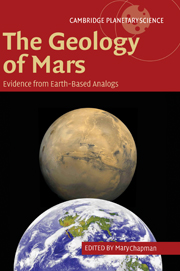Book contents
- Frontmatter
- Contents
- Preface: the rationale for planetary analog studies
- List of contributors
- 1 The geology of Mars: new insights and outstanding questions
- 2 Impact structures on Earth and Mars
- 3 Terrestrial analogs to the calderas of the Tharsis volcanoes on Mars
- 4 Volcanic features of New Mexico analogous to volcanic features on Mars
- 5 Comparison of flood lavas on Earth and Mars
- 6 Rootless volcanic cones in Iceland and on Mars
- 7 Mars interior layered deposits and terrestrial sub-ice volcanoes compared: observations and interpretations of similar geomorphic characteristics
- 8 Lava—sediment interactions on Mars: evidence and consequences
- 9 Eolian dunes and deposits in the western United States as analogs to wind-related features on Mars
- 10 Debris flows in Greenland and on Mars
- 11 Siberian rivers and Martian outflow channels: an analogy
- 12 Formation of valleys and cataclysmic flood channels on Earth and Mars
- 13 Playa environments on Earth: possible analogs for Mars
- 14 Signatures of habitats and life in Earth's high-altitude lakes: clues to Noachian aqueous environments on Mars
- 15 The Canyonlands model for planetary grabens: revised physical basis and implications
- 16 Geochemical analogs and Martian meteorites
- 17 Integrated analog mission design for planetary exploration with humans and robots
- Index
- Plate section
- References
1 - The geology of Mars: new insights and outstanding questions
Published online by Cambridge University Press: 18 September 2009
- Frontmatter
- Contents
- Preface: the rationale for planetary analog studies
- List of contributors
- 1 The geology of Mars: new insights and outstanding questions
- 2 Impact structures on Earth and Mars
- 3 Terrestrial analogs to the calderas of the Tharsis volcanoes on Mars
- 4 Volcanic features of New Mexico analogous to volcanic features on Mars
- 5 Comparison of flood lavas on Earth and Mars
- 6 Rootless volcanic cones in Iceland and on Mars
- 7 Mars interior layered deposits and terrestrial sub-ice volcanoes compared: observations and interpretations of similar geomorphic characteristics
- 8 Lava—sediment interactions on Mars: evidence and consequences
- 9 Eolian dunes and deposits in the western United States as analogs to wind-related features on Mars
- 10 Debris flows in Greenland and on Mars
- 11 Siberian rivers and Martian outflow channels: an analogy
- 12 Formation of valleys and cataclysmic flood channels on Earth and Mars
- 13 Playa environments on Earth: possible analogs for Mars
- 14 Signatures of habitats and life in Earth's high-altitude lakes: clues to Noachian aqueous environments on Mars
- 15 The Canyonlands model for planetary grabens: revised physical basis and implications
- 16 Geochemical analogs and Martian meteorites
- 17 Integrated analog mission design for planetary exploration with humans and robots
- Index
- Plate section
- References
Summary
Introduction
The major dynamic forces shaping the surfaces, crusts, and lithospheres of planets are represented by geological processes (Figures 1.1–1.6) which are linked to interaction with the atmosphere (e.g., eolian, polar), with the hydrosphere (e.g., fluvial, lacustrine), with the cryosphere (e.g., glacial and periglacial), or with the crust, lithosphere, and interior (e.g., tectonism and volcanism). Interaction with the planetary external environment also occurs, as in the case of impact cratering processes. Geological processes vary in relative importance in space and time; for example, impact cratering was a key process in forming and shaping planetary crusts in the first one-quarter of Solar System history, but its global influence has waned considerably since that time. Volcanic activity is a reflection of the thermal evolution of the planet, and varies accordingly in abundance and style.
The stratigraphic record of a planet represents the products or deposits of these geological processes and how they are arranged relative to one another. The geological history of a planet can be reconstructed from an understanding of the details of this stratigraphic record. On Mars, the geological history has been reconstructed using the global Viking image data set to delineate geological units (e.g., Greeley and Guest, 1987; Tanaka and Scott, 1987; Tanaka et al., 1992), and superposition and cross-cutting relationships to establish their relative ages, with superposed impact crater abundance tied to an absolute chronology (e.g., Hartmann and Neukum, 2001).
- Type
- Chapter
- Information
- The Geology of MarsEvidence from Earth-Based Analogs, pp. 1 - 46Publisher: Cambridge University PressPrint publication year: 2007
References
- 6
- Cited by

